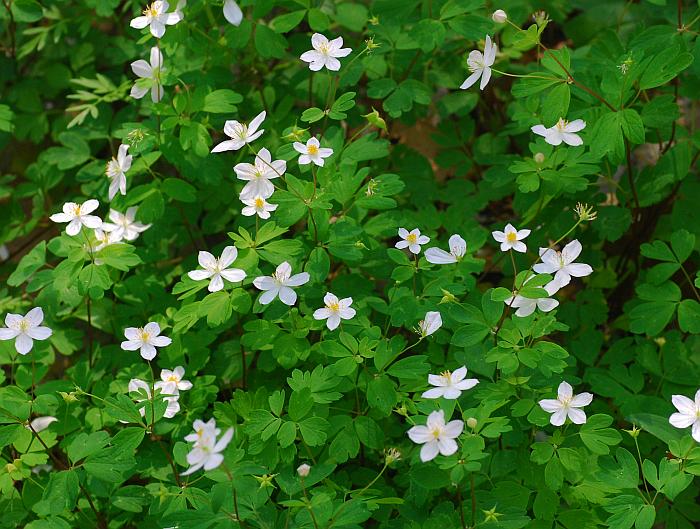Isopyrum biternatum (Raf.) Torr. & A. Gray
False Rue Anemone

Native
CC = 5
CW = 3
MOC = 60
© SRTurner
Isopyrum biternatum (Raf.) Torr. & A. GrayFalse Rue Anemone | |
 |
Native CC = 5 CW = 3 MOC = 60 |
© SRTurner |
|
Family - Ranunculaceae Habit - Perennial forb with slender, woody rhizomes. Stems - Ascending to erect, to 35 cm, glabrous.
Leaves - Alternate and basal, petiolate, ternately divided, glabrous. Basal leaves 2 or 3, on petioles to 12 cm long, glabrous. Stem leaves 1-4, progressively shorter-petiolate, the uppermost sometimes sessile or nearly so. Blades mostly twice ternately compound, those of the uppermost leaves sometimes only once ternate, the leaflets mostly 10-25 mm long, ovate to broadly lanceolate, deeply 2-or 3-lobed or-parted, the lobes rounded at the tip, sometimes again shallowly notched.
Inflorescence - Solitary flowers or loose clusters, sometimes appearing as short, leafy racemes of 2-4 flowers. Flowers becoming more dense near the apex of the stems. Pedicels glabrous, to 1 cm long.
Flowers - Actinomorphic, perfect. Sepals 5 or 6, 6-12 mm long, distinct, petaloid, white, rarely pinkish-tinged, plane, entire, rounded at the apex, slightly tapered at the base, oblong-elliptic, glabrous, not persistent at fruiting. Petals absent. Stamens numerous, arising from below the carpels, mostly erect. Filaments white, glabrous, to 4 mm long, very thin, clavate. Anthers yellow, globose. Pollen white. Pistils 2-5 in a whorl, each with 2-6 ovules, glabrous. Style 2 mm long. Stigma minute.
Fruits - Follicles, obovate in outline, flattened, the body 4-5 mm long, tapered abruptly to a slender beak 1.5-2.0 mm long, the outer wall thick, prominently veined. Receptacle not much enlarged at fruiting.
Flowering - March - May, rarely also October. Habitat - Bottomland and mesic forests, bluff bases, streambanks, ravines. Origin - Native to the U.S. Lookalikes - Thalictrum thalictroides. Other info. - You know spring has arrived when you start to see this little plant bloom. It adds a splash of white to the woodland ground otherwise drab with leaves of fall and winter. The plant forms colonies with its horizontal creeping stems, and under favorable conditions these can cover large areas with a sea of the small white flowers. The plant is common in bottomland habitats across most of Missouri and the U.S. Midwest, and ranges into Canada as well. Photographs taken at Whetstone Conservation Area, Callaway County, MO., 3-19-04, and at Eagle Bluffs Conservation Area, Boone County, MO., 3-27-04 (DETenaglia); also at Tyson County Park, St. Louis County, MO, 4-10-2011, Engelmann Woods Natural Area, Franklin County, MO, 4-12-2016, Washington State Park, Washington County, MO, 4-24-2017, Bootleg Access, Washington County, MO, 4-7-2020, Little Lost Creek Conservation Area, Warren County, MO, 4-8-2020, and Young Conservation Area, Jefferson County, MO, 4-15-2020 (SRTurner). |